Seagate Barracuda XT 2TB: SATA 6Gb/s Performance Preview
by Gary Key on October 29, 2009 12:00 AM EST- Posted in
- Storage
AnandTech Small Folder Transfer Results –
In our first storage test, we utilize a 3.82GB test folder and transfer it from our WD VelociRaptor drive to the competing hard drives.

There is only a 2% difference in performance between the two drives on the Intel P55 controller and basically a tie on the Marvell controller. We did not expect anything really different as the average sustained transfer rates between all three drives are very close.
In our second storage test, we utilize the same 3.82GB test folder and transfer it from our test hard drives to the Intel 160GB SSD.
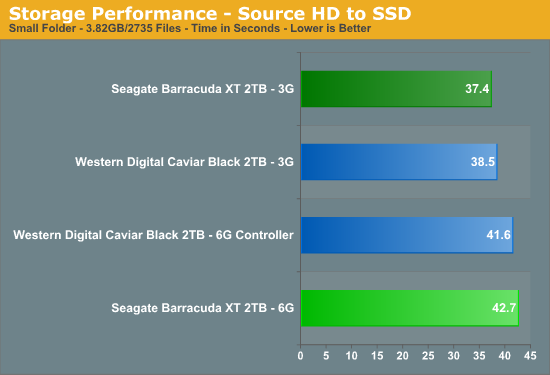
The tables flip here with the Seagate drive performing about 3% faster on the Intel controller than the WD drive. However, Seagate drive is 12% faster in this test on the Intel P55 in 3Gb/s mode than at 6Gb/s mode on the Marvell controller.
In our final small folder test, we utilize the 3.82GB test folder and transfer it from our test SSD back to the competing hard drives.

We finally see the Marvell 9128 chipset making a difference. The Seagate XT drive is 9% faster in 6Gb/s operation than in 3Gb/s mode on the Intel P55. We noticed peak transfer rates of 296MB/s on the Marvell controller compared to 262MB/s on the Intel controller with the Seagate drive. In both cases, the Seagate drive is faster in this test than the Western Digital drive.
AnandTech Large Folder Transfer Results –
In our first storage test, we utilize a 15.2GB test folder and transfer it from our WD VelociRaptor drive to the competing hard drives.
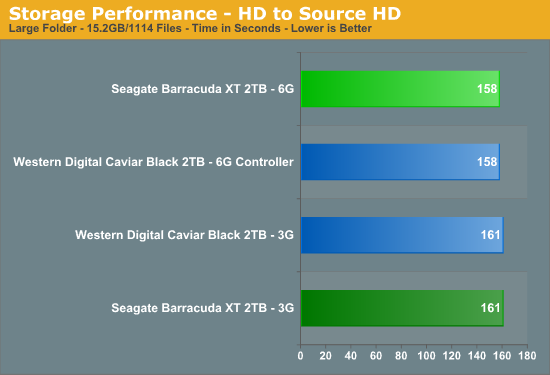
Our two drives perform identically on like controllers, the only difference here is that the Marvell controller is leading Intel in part to the aggressive 1027 driver algorithms that utilize additional system memory for transfer caching.
In our second storage test, we utilize the same 15.2GB test folder and transfer it from our test hard drives to the Intel 160GB SSD.
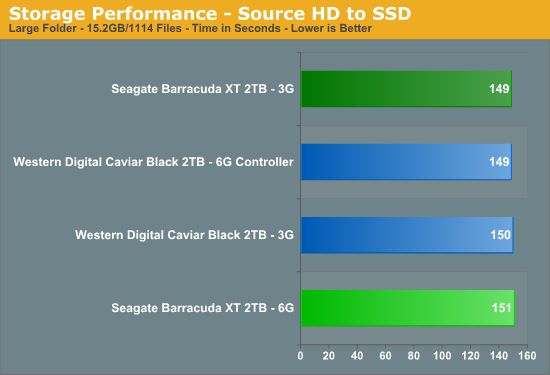
Interestingly enough, the WD drive is faster on the Marvell controller than the Intel. However, the Seagate drive benefits from the Intel controller.
In our final large folder transfer test, we utilize the 15.2GB folder and transfer it from our test SSD back to the competing hard drives.
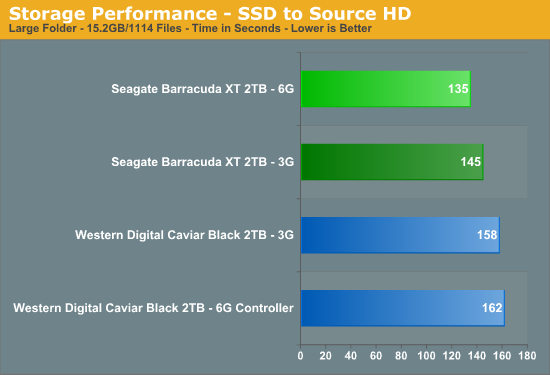
Like our small folder test, we see the benefits of the Marvell Controller in SATA 6Gb/s mode as the Seagate drive is 7% faster than it is in SATA 3Gb/s operation. The WD drive is up to 17% slower in this particular test.
PCMark Vantage x64 Results –
We are showing the total score for the PCMark Vantage disk benchmark as a reference point between the two controllers and drives.
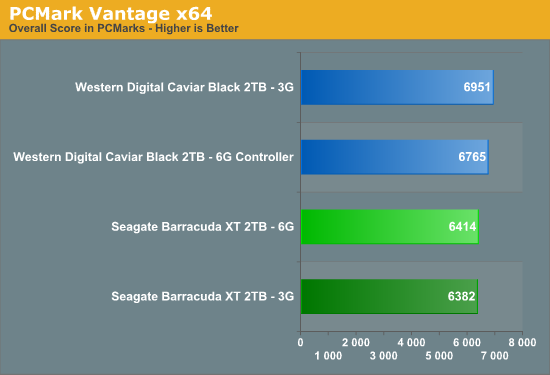
The Seagate XT drive in SATA 6Gb/s mode on the Marvell controller is barely faster than SATA 3Gb/s mode on the Intel controller. The WD drive is just flat out faster in this particular benchmark with the Intel controller being about 3% faster than the Marvell controller.
Quick Thoughts:
That was a letdown in several ways. We never really expected that much out of SATA 6Gb/s technology as our two hard drive samples are just now pushing the boundaries of SATA 1.5Gb/s. Only when we utilized a fast SSD as the source drive to copy files to the Seagate Barracuda XT did we see an advantage in the burst rates available on it and the Marvell 9123 chipset. Even then, the advantage was fleeting as the sustained transfer rates equalized quickly between the two controllers. This test is just the opposite of what a typical user would perform anyway as most would utilize the hard drive for storage purposes and not the SSD.
Even more disturbing was the performance disparity between the Seagate Barracuda XT 2TB and the Western Digital Caviar Black 2TB drive in our limited benchmark test suite. We expected more from the Seagate drive based on its specifications, not the 6Gb/s abilities but platter design and cache setups. Hopefully Seagate can improve performance with firmware changes, if not; the battle is already lost regardless of controller technology.
We just do not see SATA 6Gb/s technology offering any real benefits for spindle-based hard drives on the desktop at this time. Rotational speeds are being kept in check at 7,200rpm with all the performance improvements coming from increased areal densities and cache. We expect SATA 6Gb/s to really come into its own with solid state drives. This will not occur quickly but we expect to see recognizable benefits with controller designs about two generations ahead of where we are currently. By that time, both AMD and Intel will have native 6Gb/s capabilities on their controller hubs.
In the meantime, we see the current implementations of 6Gb/s technology on motherboards as being a marketing checklist feature for the most part. However, since the Marvell 9123 chipset can fall back to SATA 3Gb/s or 1.5Gb/s operational mode it does offer additional SATA ports on the motherboard with performance that is fine for secondary storage devices.










55 Comments
View All Comments
HangFire - Thursday, October 29, 2009 - link
This is what I expected- there is no real need for 6Gb/S SATA.SAS, on the other hand, which (for lower speeds, at least) uses the same connector technology, has a real need for 6Gb/S, since there is typically a RAID on the other end of the SAS cable.
Unfortunately, I didn't see even a passing mention of when, or if, this technology is coming to SAS.
7Enigma - Thursday, October 29, 2009 - link
Anand,Did you get your 3G and 6G mixed up? If not your first 2 charts showing your custom HD tests show the 6G 15-20% slower than the 3G. Your commentary doesn't say anything about the 3G/6G comparison, only the differences between the brands...
7Enigma - Thursday, October 29, 2009 - link
Yikes, I completely misread your comments. That's what I get for posting before double-checking. Please disregard my initial post!Pastuch - Thursday, October 29, 2009 - link
2TB Performance? Who cares... Give us more Anand Home Theater blogs! Now those are interesting!All we really want to know is if these new Seagates are more reliable than the Seagate 7200.11s or the WD Greens. In fact if you look at all of the drives over 1TB there are VERY FEW that are reliable.
The HD manufacturers need to forget 2tb and move to 4tb drives asap. My blu-ray backups already take up 5 Terabytes and it's growing exponentially.
If we wanted HD performance we'd be reading your SSD articles ;)
falc0ne - Thursday, November 5, 2009 - link
bluray backups...maaan are u nuts? :))this is an example with:"don't do this at home" :))
Woa you should have seen my 'weddings' bluray movie backup: it takes 2000TB maan i've attended to many weddings:)
Second thoughts: seriously thinking in asking IBM or Google to host my backups:))
JEDIYoda - Friday, October 30, 2009 - link
We all care about 2T performance nice review. Thanks for touching on things we all care about!!Nobody gives a fuck about 4T drives especially when only one person is crying like a weenie. Especially when that weenie is so misinformed about the reliability of drives ovcer 1T!!!
Muahahaha
kmmatney - Thursday, October 29, 2009 - link
"All we really want to know is if these new Seagates are more reliable than the Seagate 7200.11s or the WD Greens. In fact if you look at all of the drives over 1TB there are VERY FEW that are reliable."Exactly. The only thing that is really important with these large drives is how reliable they are. Youc an't really inlcude that in a review of a new product, but really this is way more important than all the other benchmarks. These drives are used for backup and storage and need to be reliable.
Gholam - Monday, November 2, 2009 - link
I don't really care about individual drive reliability. There is no drive that is 100% reliable, and as long as you take proper precautions, drive failures are inconsequential.SunSamurai - Thursday, October 29, 2009 - link
SIlly person, dont you see where the true potential of these lay?I would order 1000 of these for a server farm based on the simple fact that in the tests they are taking -1% CPU time. Over 1000 of these drives thats 10x cpu performance! =D
atlmann10 - Friday, October 30, 2009 - link
Wow Silly person that's an insult. Well Mr name caller, I would let you know that if you bought 1000 of these and ran your sever farm on SSD drives specifically, especially watching for upgrades in SSD tech you would be loosing. The SSD debate is over anyway now, as Intel said today that SSD drives could not diminish in nand size past 22nm today. What this means is that if it is at 32nm and we go by there tick/tock theory, and we also look at how fast this technology has been moving is, you would have no more than a year and a half max on your time line. After that there will be no greater Nand flash drives. So your server farm would die in a year and a half. I imagine you would recognize a return on your investment in 2-3 years. So if your giving away money I'll send you my address.